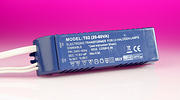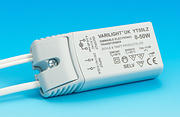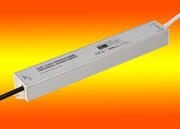A standard extra low voltage power supply like this
has both a max and min load in this case max 60W min 20W and as a result the load using a LED is too low. There are now versions
which as with this one go from 0 - 50W but not as common. These are not transformers but an electronic power supply normally using switched mode method of control which for a quartz halogen makes the lamp last longer. There are true transformers
used to allow extra low voltage lamps in places like bathrooms but these have no control so low voltage in means low voltage out. The LED driver give out DC as shown here
not all LED lamps are the same some will work on AC or DC and as long as the power supply will go low enough they will work so can use 3 out of the 4 shown other want a DC only supply these are even some Philips lamps which Philips claim will run off all 4 types seems the lamp kids the power supply that it's giving out enough power so they do not turn off under under current fault control.
The whole idea of the switch mode power supply was to power VCR's without producing too much heat so although warm they should not run that hot but it will vary make to make.
The word "Driver" also refers to consent current devices I have used these on airports but have not come across any used with domestic lighting.
Unless bought as a kit it is so easy to get a miss match specially if you want to dim lamps and I would think with the exception to special areas where extra low voltage is required for safety like certain areas in a bathroom the low voltage (230v) lamps are far better today. There are three types of holder the GZ10 fits all the GU10 will not allow dichroic lamps to fit as these send heat out of the back so not getting subject as warm and the L2 will only allow some LED versions to be used and are really to get around new build rules on energy saving.
There are some problems with bulb length some cold cathode lamps and older LED lamps are longer than the old quartz halogen types but the 12 volt fittings will not run cold cathode (florescent) lamps at all.
Power supply temperature depends on the efficiency of the power supply and the cooling available and so since we can't measure the amount of cooling the only protection is when the power supply goes into auto shut down due to over temperature all though some claim "Thermal and Overload protection. Both of these features are fully reversible so as not to damage the transformer or any equipment on the circuit." what it does not state is the temperature that this protection cuts in at. Many give a max ambient temp of 40 deg C and in a ceiling void heated by a quartz halogen lamp this could easy be exceeded.
In many cases little thought is given to over heating and they are just popped into the ceiling void. With the quartz halogen lamps the control offered by the power supply did extend the lamp life however the problem of power supply failure and the ease at swapping lamp types with low voltage plus the problems where wrong types could be fitted with the MR16 fitting has resulted in the extra low voltage type losing favour.
The situation is not made any easier where inverters are still called incorrectly transformers and extra low voltage (under 50vac) is called low voltage on many packets (low voltage is 50vac to 1000vac). Also angles of beam vary so much typically 60 deg to 38 deg although tighter beams are made. Where reflected off a white surface not too much a problem but I have seen it where they remind me of a planetarium with little clusters of 3 to 9 planets.
Lighting is an art and I must admit in some kitchens with white shiny cupboards it has worked well but replace the doors for dark wood and total failure. I use GU10 lamps as bedside reading lamps and to reach dark areas but would never use for general lighting.





